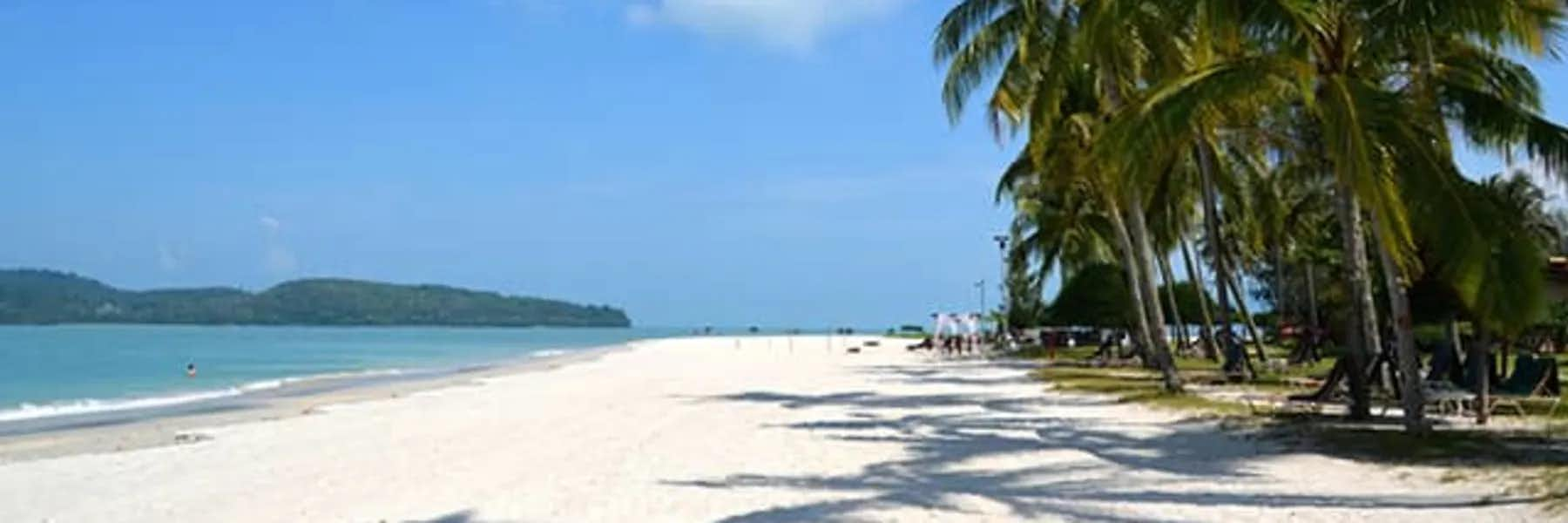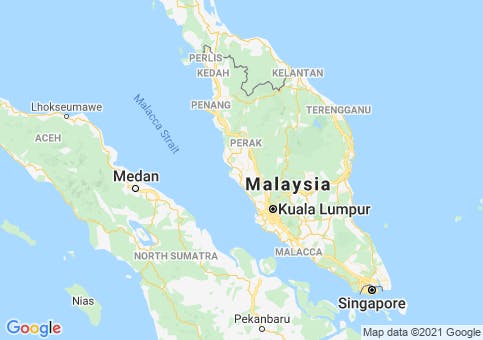Langkawi is actually the name of a group of 99 islands, 104 at low tide if you are actually counting. Pulau Langkawi however is the largest island in the group and one of only a handful of the islands that is inhabited.
This extraordinarily gorgeous hideaway in the Straits of Malacca is just a stone’s throw from Thailand, and many of its residents head into Thailand at weekends for shopping or just for an island break. And although Pulau Langkawi is probably only really a suitable location for a holiday home, its north-coast beaches are among Asia’s finest.
Sprinkled with tiny exotic seashells, the sands really are talcum powder white and squeak as you walk on it. On the horizon, jungle-clad limestone formations look like a scroll painting. Your eyes are constantly drawn to the bobbing little boats of anchovy fishermen on the horizon and sea eagles riding the ocean thermals closer to shore.
And of course, there are expats who live here on a permanent basis. These expats like a quieter, slower pace of life, untroubled by traffic jams and the glitzy shopping malls of Penang and Kuala Lumpur. The majority of them run their own businesses such as boutique hotels and yacht charters, there’s even one who makes and sells beef jerky and exports it to Penang and Kuala Lumpur. For them this small island is paradise and they wouldn’t live anywhere else.
Pulau Langkawi has jungle too and lots of it. If you enjoy back-to-nature experiences, it’s magical to glimpse hornbills and white-headed Brahminy Kites swooping through the treetops, to come face-to-face with monitor lizards, and to hear the night-time chorus of croaking frogs.
The island is also home to flying snakes (non-poisonous) that fly from tree to tree, large fruit bats, colugas (gliding lemurs), and a host of other wildlife including kingfishers, muntjac deer, and gentle black leaf monkeys. There are snakes as well, a variety of them, but you don’t see them that often, if at all. In the nine years that I have been hiking the trails here, I’ve only seen them a handful of times. All you have to remember in the event of seeing one is that they will do all that they can to get out of your way long before you decide to get out of theirs.
Living in Langkawi
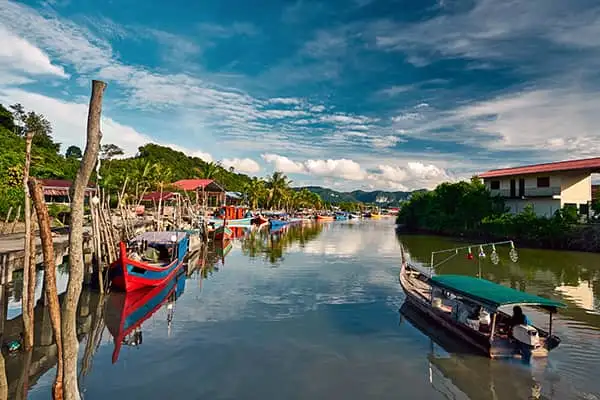
The majority of the Langkawi archipelago’s 65,000 mostly Malay inhabitants live on Pulau Langkawi in traditional kampongs (villages) of stilted wooden houses. Backing onto the villages are rice fields with greywater buffalo sleeping under the molten midday sun. They use the buffalo to plow the fields and they’re a delight to see. They are also used in races throughout the year, when the farmer’s come together usually at the beginning and end of a harvest. Shackled with a lightweight plow the race takes place in a paddy field with the driver standing on the plow. Usually, the one left standing wins the race.
Villagers use the steps of their houses to sit and mend fishing nets or shuck vegetables or just chat with their neighbors. The other thing that you will notice is that they have an amazing sense of humor and like nothing better than sharing a cup of tea and a joke with strangers. Shy toddlers peep out from behind trees and wave at you as you pass, like a long-lost member of the family.
Most of the Pulau Langkawi is untouched by humans; a wilderness of mountains, waterfalls, and rainforest and that can make living on the island a little quiet. It has its attraction but if you are looking for international-standard restaurants, nightclubs, and bars, then Langkawi isn’t the place for you. It’s a resort island and the expats who do live there, live there precisely because it has none of the above.
Langkawi, as well as being stunningly beautiful, is a tax-free island, meaning that all goods, including alcohol, are tax-exempt. This unique combination of natural beauty and dollar-saving incentive is a big attraction and it’s easy to understand why people never leave.
Reaching Langkawi involves a one-and-a-half-hour flight from Malaysia’s capital, Kuala Lumpur, or a 40-minute flight from Penang. Alternatively, you can come via ferry from either the mainland, an enjoyable half-hour ride, or from Penang Island, which takes a little over two hours. The ferry has just started to allow cars too, which means you can now take your car with you and use it to get around the island.
Healthcare in Pulau Langkawi
Pulau Langkawi has its own 110-bed hospital set in 53 acres. It is capable of handling most emergencies but not specialist issues and for a truly Western-standard hospital, Penang (a medical center of excellence and a 40-minute flight away), would be your best choice.
There are also a number of Government medical clinics scattered throughout the island, staffed by GPs.
Cost of Living in Langkawi
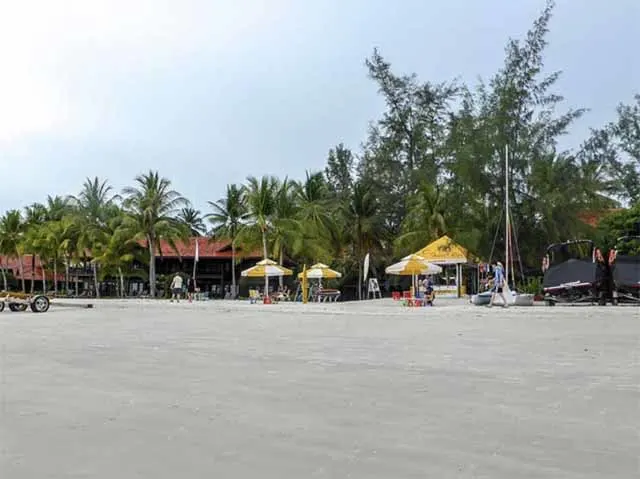
The cost of living in Malaysia is a fraction of the cost of living back home and Pulau Langkawi is slightly cheaper than the rest of Malaysia. That means that your dollar goes a lot further in Langkawi, an island that has all the comforts of home.
A couple can easily live on less than $900 a month. An entire bag full of fresh fruit, including mangoes, bananas, apples, oranges, and pineapples, cost just $3.50. High-speed Internet is reliable and costs $26 a month and a premier pay-TV package will run you about $35 a month.
| Expense | Cost |
|---|---|
| Rent | $413 |
| Electricity | $48 |
| Water | $1 |
| Cooking gas | $1 |
| Internet | $26 |
| TV | $35 |
| Maid (full-time, 6.5 days a week) | $204 |
| Car (gas) | $28 |
| Entertainment | $138 |
| Total | $894 |
Langkawi: Tranquility and Wildlife Off the Coast of Malaysia
by Keith Hockton
The vibe of Langkawi, also known as the Jewel of Kedah, is one of a laid-back island. If it’s beaches and wildlife that you’re after, Langkawi is probably the Malaysian Island to head to—and Malaysia does have a few to choose from.
This tropical archipelago is off the beaten tourist trail, and although geographically close to Thailand it attracts backpackers of an older more sophisticated type. The hotels are a little bit more expensive than in Thailand and there is a good selection of five star hotels to choose from (The Danna, The Datai, The Andaman, The Westin, and The Sheraton). There are also some wonderful boutique hotels and lots of clean backpacker hostels to suit everyone’s budget.
Langkawi lies on the northwestern tip of Malaysia and if you haven’t heard of it, you are in good company. It’s a mixture of picturesque paddy fields, sheer craggy limestone mountains, thick jungle and unspoiled mangrove swamps. It also boasts the Kilim Karst Geoforest Park, the first UNESCO listed Geopark in all of Asia, and is home to the famous crab-eating macaque.
A Snowbird’s Paradise
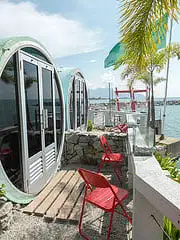
An island steeped in legends, the story behind Gunung Mat Cincang and its neighboring peak Gunung Raya, the island’s two highest peaks, is one of the most romantic. These two mountains were once two giants who were lovers. At the wedding of their children, they fell out and had a scrap, spilling gravy and breaking pots and pans. The gravy spillage became the coastal town of Kuah (which means gravy in Malay), and the neighboring village of Belanga Pecah (or broken crockery) was born from the pots and pans. Finally coming to their senses and ashamed of their behavior, they chose to be turned into mountains. Mat Sawar, their mediator, was also turned into a small hill, and to this day he lies wedged between the two peaks, keeping a watchful eye over them.
The drive from Langkawi international airport to most of the hotels takes you through sleepy Malay villages, with established low-level homes on stilts surrounded with colorful verandahs, yawning dogs, chickens, and paddy fields. You’ll pass hundreds of acres of virgin rainforest and row upon row of planted rubber trees without a single sign of tourism anywhere. It’s easy to see why this island is so popular and why people tend to stay as long as they do.
When you enter Malaysia you’ll get a three-month visa. Quite a few of the tourists my age (early 50s) bunker down for the entire three months, returning to Europe and North America tanned and happy, as their winter starts to thaw. And it's a place that they return to each year—a number of people I met on the beach or at lunch were returning for their fourth and fifth year in a row.
The roads to the hotel are comparatively empty save the occasional motorbike, and groups of grooming monkeys using the highway like their own personal tanning salon. It took me less than eight minutes to drive to the Bon Ton Temple Tree Resort.
This eight-villa hotel is an eclectic mix of heritage buildings disassembled from different parts of Malaysia and re-assembled. With names like Silk, Black Coral, and Blue Ginger, they claim to be over 100 years old. I eventually settled on one facing the pool. The pool itself was delightful—there were no children in sight, and the restaurant, which is one of the best on the island, overlooks a natural lagoon. Filled with a multitude of local exotic birdlife I stood on my verandah and witnessed an eagle swooping down to pluck a small fish from the surface, only to be attacked by another eagle that sought to steal it. It was far better than tuning in to National Geographic and I came to realize that this is one of Langkawi’s main draw cards. Its fauna is spectacular.
That evening, having dinner in the alfresco restaurant, the only sounds as the sun set were the hundreds of birds in the lagoon as they settled down for the night. Minutes later, when they had presumably settled, there was absolute silence. I was reminded of the movie Out of Africa and at one stage fully expected Meryl Streep to join me at my table. “There isn’t a great deal to do here,” admitted Alison, one of the owners of Temple Tree, as we sat and chatted. “Things here tend to be a little more expensive than Penang and there isn’t such a variety of crafts. People come here for the beaches, the solitude, and the wildlife.”
Great Hospitality and White Sand Beaches
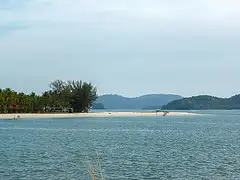
Just down the road from the resort is one of Langkawi’s more popular beaches, Pantai Cenang. The strip of shops, restaurants, and hotels that run parallel to the beach were unassuming, inviting, and tranquil. The beach itself was gorgeous. A mixture of white sand and crystal clear turquoise water fringed with an abundance of coconut palms.
Planting myself next to a coconut seller I asked for one to go. After cutting the top off and offering it to me, he stopped and withdrew it saying, “You look hot. Let me get you a chilled one. It will make you feel wonderful.” He was right, and for just $1 I had another.
The area of Pantai Cenang, near the island’s southwestern tip, is the island’s most vibrant tourist hub. Pantai Cenang also has the best waterfront nightlife on the island, where the numerous bars offer a laidback atmosphere filled with Motown tunes and cold beer. I met a lot of tourists here, and it's a good place to pick up information about what’s happening around the rest of the island.
Kuah, the main town, is on the southeast corner of the island, while most of the larger five-star resorts are on the northwest coast. In-between and around the fringes are deserted beaches, and numerous wildlife parks which are the main attraction.
No matter how much time you have on the island, be it a few days or a few months, the Kilim Karst Geoforest Park tour is a must. There are different packages to choose from and for $20 I really felt that I got value for my money. The Bat Cave was awesome and the forest itself is stunning. Seeing eagles fishing naturally just feet from our boat is something that I’ll always remember.
I’m not a beach bunny—I would rather be active than sit on the beach—and Langkawi gave me all the options that I asked for and more. Its beaches, stunning mountains, enchanting forests, superb diving, and some remarkable restaurants, make it a destination unlike any other in Malaysia.
The best time to visit Langkawi is from December to March, the dry season. This is the season of blossoms, courtship, and nesting, with refreshing sea breezes keeping temperatures from climbing much above 86 F. August to October is the wettest period with monsoonal downpours so heavy and so noisy it’s impossible to hear the person next to you talk.
Things to Do in Langkawi
By Keith Hockton
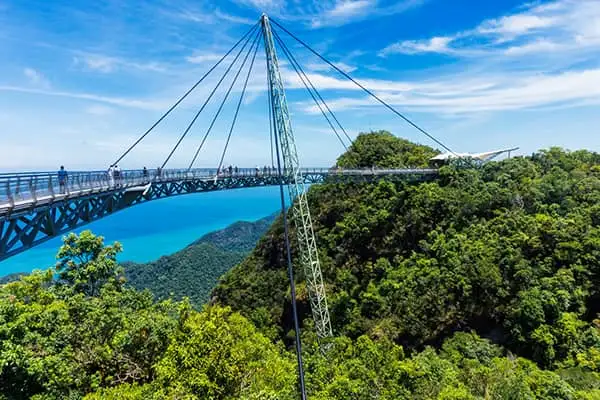
Langkawi is an archipelago of some 100 islands just 18 miles off Malaysia's northwest coast. It's known for white-sand beaches, clear blue water, and stunning mountain backdrops. Its colorful fauna and flora, especially for bird watchers, is a large drawcard. The majority of the islands in this beautiful archipelago are uninhabited, and just so that you know, when you mention Langkawi, everyone knows you are talking about the main island.
On the main island itself, also called Langkawi, the Sky Cab cable car runs to and from the top of Machincang mountain. From its summit and sweeping vistas, the Sky Bridge curves out high above the treetops giving you a 360-degree view of the island and all that she has to offer. There are over 100 different trails here ranging from easy to extreme and plenty of locals who will guide you for a small fee or offer you advice. Two trails run through the jungle to the Telaga Tujuh waterfalls, including the impressive Seven Wells Waterfall, and the Kilim Karst Geoforest Park. On a scale of one to 10 with 10 being extreme both of these rates a one.
Of all the things to do in Langkawi, the Kilim Karst Geoforest Park is my favorite spot. Drop-dead gorgeous is an overused cliché but it is actually appropriate here. Spanning some 621 square miles it is home to 1,000-year mangrove forests and caves whose tunnels are so numerous they are still being explored. And let’s not forget the vertical karstic hills. There is a lot to do here, and one day won’t do the park justice, think Jurassic Park without the dinosaurs, and its laid back vibe takes you to another place and time. That being said we did pass numerous six-foot-long water monitor lizards, which added to the whole Jurassic Park feel, and as harmless as they are I don’t advise getting too close. Their tail is the danger, as it’s long and jagged, and if they turn and run and it swipes you it will leave a nasty graze.
There’s a good variety of wildlife here as well ranging from sea and land otters and sea and land monitor lizards, to numerous large groups of macaques, and tree crabs bigger than a dinner serving plate. These are a local delicacy, and consequently nervous around visitors, but you will find them hiding amongst the thick mangroves. Their pincers could alone make for a tasty meal for two. During the migratory seasons (September to March), you can also spot birdlife of varying species, including kingfishers, distinctive with their deep blue plumage, white-bellied fish eagles with their impressive wingspans, and the smaller kite eagles. Interestingly they all get along due to the fact the fish life is so rich and abundant in the mangroves.
The backdrop of the forest is impressive as well, and intermittently scattered throughout are numerous ancient limestone formations, most over 500 million years old. These formations have been given unique names by the locals and although some of the names have changed in the last 20 years the guides will know what you are asking for. My favorites are the Temple of Borobudur, the Elephant Stone, and the Hanging Gardens. There are others, many others, but if you want your knock your socks off impressive for your Instagram account these are the ones that you should tell your guides to take you to.
The subterranean caves in and around them are filled not just with fossils, and you see them everywhere, but also gigantic stalagmites and stalactites. If geology is your bag, actually even if it isn’t, ask the guide to take you to Crocodile Cave, Cave of Legends, and the Bat Cave where they are the most impressive. Be aware, as much as you will be tempted to, do not pick up anything that takes your fancy, it’s strictly against the law. Located 1.86 miles northeast of Tanjung Rhu Beach plan for a full day and take as much water as you think you will need. The guides will carry extra but better to be safe than sorry.
Langkawi isn’t a large island, in fact, you can drive around her in a day, and although there are lots of outdoor activities to keep you occupied, sometimes just chilling at the beach or by the hotel pool with intermittent short trips is the way to go. The larger trips can be planned, and actually, you will have to book, but these ones you can do at the drop of a hat.
Eagle Square, called Dataran Lang in Malay, is one of the most iconic spots in Kuah, the main town on the island. Standing some 40 feet high this huge statue of an eagle about to take flight is impressive. It’s also typically Malay, and if you travel further afield to any of the towns on the east coast you will see similar dedications to animals that they revere in their folklore. Malay culture is based on anilinism, and animal and tree spirit statues are commonplace.
Eagle Square is also close to a number of other attractions such as Taman Legenda Langkawi, a quirky Malay folklore park with lots more eagle and flower type attractions, and you can combine a trip here with several other points of interest. As well as the Eagle statue, Dataran Lang has some picturesque fountains (don’t think the Trevi Fountain), six of them, four scenic bridges, and numerous good restaurants and cafes. Arts Café serves the best coffee by far, but Tip Top Bites and Café Langkawi are worth a visit for their cakes and juices.
Galleria Perdana, just minutes away, is one of the most interesting museums in Langkawi, if not Malaysia, and was founded by Dr. Mahathir Mohamad who was the longest-serving prime minister of Malaysia. The museum is dedicated to showcasing just some of the gifts that Mahathir received during his time in office, the majority of which were given to him by visiting heads of state. Dr. Mahathir spent a lot of time in Langkawi as a boy and it’s and when he was re-elected PM recently Langkawi was one of the first places that he visited. No doubt adding more gifts to his already well-stocked museum.
Amongst the eye-raising paraphernalia is a formula one racing car, there were two and one seems to have gone missing, and a large number of vases, over 200 of them, featuring the former prime minister's image. The ceilings are also impressive as they have been hand-painted by some of Langkawi’s leading artists. Take a pair of binoculars with you as they are rather high, but the detail is exquisite.
A must visit and one of the jewels in Langkawi’s crown is the Langkawi Cable Car which takes you to the top of Mount Machincang. The leisurely journey over ancient rainforests and impressive waterfalls, takes around 15 minutes, and you will wish that it took longer.
Machincang mountain is Langkawi’s second highest peak, standing at a height of 2,322 feet. There is an observatory deck at the summit that also serves cold drinks and tea and coffee and on a clear day if you look east you can see all the way across to Sumatra, in neighboring Indonesia and west, the rolling hils of Thailand . The cable car leaves from the Oriental Village. There is plenty of parking here and if you arrive early I would recommend exploring it first before the heat of the day starts to overwhelm you.
Mount Gunung Raya, at 2,890 feet, is Langkawi’s highest peak and well worth the visit. This is also where a giant god by the name of Mat Raya was said to have cursed the island. Local lore has it that Langkawi was once home to a roving band of giants. Mat Raya and Mat Cincang were two giants who were the best of friends. The son of Mat Cincang and the daughter of Mat Raya fell in love with each other and the two giants agreed to the union of their two children.
During the wedding ceremony, Mat Raya became angry when he noticed the bridegroom making eyes at someone else other than his daughter. The two giants argued and violence ensued. As the two giants fought, a third giant, Mat Sawar, tried to intervene and separate them. Suddenly a bolt of lightning struck down from the heavens and as the giants looked up they all turned to stone. Mat Cincang became Gunung Mat Cincang, which is now the second tallest peak on Langkawi (home to the cable-car ride), and Mat Raya became Gunung Raya, the tallest peak in Langkawi. Mat Sawar became Bukit Sawar, a small hill in-between Gunung Mat Cincang and Mat Raya, still valiantly trying to separate the two.
The hike to the top of the mountain is rather steep in parts, and you can either go it alone or you can hire a guide. On your way to the top you will pass wide swathes of primary rainforest, reported to be over 1 million years old, and you will see animals like flying foxes, monkeys, tree climbing forest monitor lizards (yes, they live in the trees), numerous eagles, and hornbills! This is exciting as you don’t see them in Penang, there isn’t enough food for them here, and of course a plethora of other colorful birds. I’m not a birder, but I did meet a group of birders from Finland (they all live in Penang), who were happy for the three hours that I had left to enthrall me with their finds.
If you are a birder and coming to Malaysia for the first time I can highly recommend “Birds of Malaysia by Geoffrey Davison, Yeap Chin Aik.
How to Spend 48 Hours in Langkawi: Asia’s Island of Waterfalls
By Kirsten Raccuia
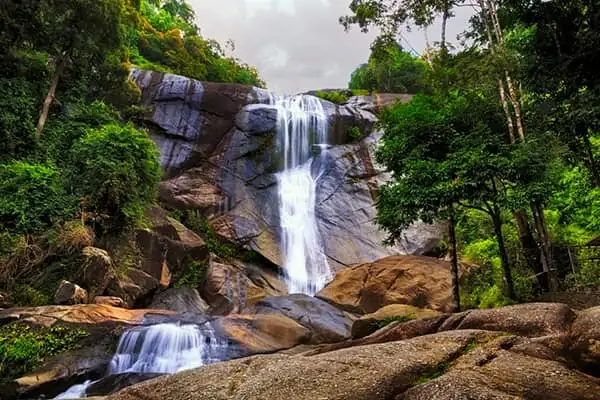
Most people who come to Malaysia spend a lot of their time in the capital, Kuala Lumpur. Some pop over to Penang for a few days, which is well worth the trip, too. But if you stop at that, you’re missing out on a nearby tropical island that has picture-postcard blue waters and a lush, green interior.
Langkawi is a pure island paradise just off the west coast of Malaysia. From Kuala Lumpur, it’s only an hour’s flight and from Penang, it’s just 17 minutes. To be exact, Langkawi is an archipelago made up of 99 islands, and the landscape is astonishing. Limestone karsts jut out of the azure ocean. Deep green jungle covers tiny uninhabited islands dropped like pins in the middle of a marine park.
Besides the gorgeous beaches and rushing waterfalls, there is plenty of adrenaline-pumping adventure on the main island of Langkawi. Or if shopping is more your speed, the island was designated duty-free in 1987, so you’re in luck for bargains.
The first time I went, I planned to plop myself down on a beach and not move. That all changed when I got there and saw all the activities on offer. Then I couldn’t sit still. That doesn’t mean that I didn’t get my fill of beaches. Quite the contrary; it meant I had to explore them all!You can drive around the whole island in a few hours.The most popular areas to stay, shop, and eat, are Pantai Cenang and Pantai Tengah, near the southern tip of the island. You can drive around the whole island in a few hours, so it doesn’t matter where you stay, but if you want any sort of liveliness, these areas are the best. Personally, I like to stay at Ambong-Ambong for boutique vibes, or Pelangi Resort if I’m feeling more indulgent. Both are in Pantai Tengah.
Be warned, there is no public transportation on the island, so you’ll have to hop in a Grab (Southeast Asia’s version of Uber) or rent a scooter or car.
WHEN TO GO
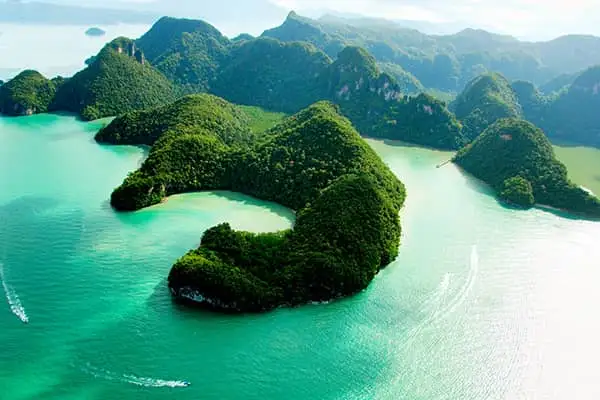
Langkawi is just six degrees north of the equator—it’s always hot and humid with a chance of showers.
January to March is when it’s driest. September and October are the wet-test. And every other month varies in between. There is no distinct monsoon season, and in the rainy months, it mostly storms at night, so your beach days won’t be ruined. However, if you plan to dive or snorkel, the visibility will be significantly affected by the rains.
Day 1: Morning
Start your tour at the highest vantage point on the island. Head straight to the Oriental Village on the west coast, the jumping-off point for Langkawi’s SkyCab. It is one of the steepest and also the longest free-span monocable cars in the world.
The 2.73 mile-long ride takes you over the 550-million-year-old Mount Machinchang, and gives some wonderful elevated views of the lush forest canopy. As you ascend, be on the lookout for a break in the jungle—it’s a nearby waterfall. At the intermediate stop along the way, get out and take in a close-up view of the blanket of hot pink and purple flowers covering the mountain.
Hop back on the Swiss-designed cable car and ride the rest of the way to the top. At 2,300 feet above sea level, you’ll have dramatic 360-degree views of all the nearby islands, including Koh Lipe in Thailand.
Once you’re at the top, buy a ticket to the SkyBridge ($1.50), the longest free-span curved bridge in the world (Malaysia has a thing for breaking records). The 410-foot long bridge is suspended 320 feet above the jungle floor. It had to be airlifted to the top of the mountain by helicopter and assembled in its current spot.
As you walk from one side to the other, you are walking in between the mountain tops. Stop at the glass panels along the bridge for photo opportunities.
You can buy combination tickets for the cable car, SkyBridge, 3D art museum, and SkyRex multimedia attraction when you get there for $20 or choose the express lane for $33. Both tickets include entrance to a few other attractions. But your time is limited, and you have waterfalls to hunt.
If all those Sky activities have you hungry, there are dozens of local food options to choose from.
Day 1: Afternoon
When you are through with lunch, make your way to that waterfall you spied out of the gondola. It’s called Seven Wells Waterfall, or Telaga Tujuh, and it’s only five minutes away by Grab. Once you arrive at the car park, it’s an easy walk to the top of the waterfall—a perfect time to spot macaques and hornbills.
After cooling off in the falls, head north about 20 minutes (by car) to the Terjun Temurun waterfall; it’s the highest on the island. From Terjun Temurun waterfall, you’re two minutes away from Sandy Skulls Beach.
Don’t let the name fool you. Across the horizon you can see Koh Tarutao, which used to be a Thai penal colony. Legend has it that body parts used to float ashore on this beach, hence the name.
It’s one of the prettiest beaches on the island and is quite small, so don’t expect any facilities other than a bathroom. There is ample shade under the trees and no watersports in sight, making for a calm place to spend the afternoon.
Day 1: Evening
At 5:30 or so, head back toward Cenang Beach. The ride takes about 30 minutes.The local Tiger beers are cheap at $1.25.Go to Ah Chong beach bar in time for a sundown drink. The local Tiger beers are cheap ($1.25), and they make a mean craft cocktail for $5. I’m a sucker for their Tanqueray Basilikum: gin, fresh basil, lemon juice, a little syrup, and fresh-ground pepper on top. You can’t go wrong with their Negroni either.
Ah Chong isn’t fancy; it’s a wooden bar with rickety chairs and some tables in the sand. But it’s the perfect spot to watch the sunset, which will undoubtedly be magnificent—they always are in Langkawi.
After the sun sets, you’ll be right in the center of Cenang Beach and within walking distance to all sorts of eateries. For local seafood, try Palm View Seafood. For Western fare and pizza, Red Tomato is delicious.
ALTERNATIVE OPTIONS FOR RAINY DAYS
If you happen to find yourself in Langkawi on a rainy day, there is plenty to do outside of shopping.
Underwater World—A massive aquarium with more than 4,000 species to marvel at.
Kraf Kompleks—A group of museums dedicated to traditional crafts and artifacts from around Malaysia.
Atma Alam Batik Art Village—If you want to shop for batiks or try to make your own, you can do it here. The artists
Day 2: Morning and Afternoon
This morning you have a couple of options. Depending on your need for speed, you can take a leisurely half-day mangrove tour, or hire a jet ski for an adrenaline-fueled island-hopping tour.
If mangroves are more your pace, take a tour to the northeastern part of the island and the Kilim Geoforest Park. This is a 38-square-mile UNESCO World Heritage nature site with thick mangroves and dramatic karst rock formations. You’ll get a close-up view of the limestone outcrops you saw from the SkyCab.
During the tour, you’ll spot monitor lizards, macaques, and two types of eagles that nest in the park. The more extended tours take you through bat caves and various neighboring islands. No matter which tour you choose, you’ll have time for a swim.
Tour operators are available all around the island, as well as in the park itself. Some of the less reputable ones feed the eagles chicken to get them closer to the tourists. It’s not good for the eagles to rely on humans for food, so look into that before you decide.
Also, make sure that the tour has an actual wildlife guide or naturalist on board. Langkawi boasts more than 200 species of birds, and without someone who knows what to look for, you’ll miss a lot. Dev’s Adventure Tours is good, and eco-friendly.
If you’re looking for an adrenaline rush, hire a jet ski and take a guided tour to the nearby islands.
Visit the fjords, where you’ll squeak through passageways so narrow that they’re sure to test you if you’re claustrophobic. You’ll also visit Dayang Bunting (Pregnant Maiden) Island, which has the largest freshwater lake in Malaysia, separated from the sea by a thin crest of limestone.
Although the shape of the island looks like a pregnant woman lying on her back, strangely enough, that is not why it is called Pregnant Maiden Island. Folklore has it that a princess, Walinong Sari, laid her baby son to rest in the lake and prayed for all women who wanted children. Since then, it’s believed that if you take a dip in the lake, you’ll become extra fertile.
Depending on the amount of time allotted and the tour company you choose, you can visit up to eight islands on your tour.
Day 2: Evening
No matter what your morning looks like, head back to Cenang Beach for evening drinks. For a laidback sunset, check out Kalut Bar. Grab one of their bean bags on the beach and melt into the evening.
For a more upscale atmosphere, walk to the end of the beach to The Cliff. It’s one of the nicest restaurants in Cenang and has a complete view of the beach. They also happen to have good happy hour specials and pour pretty stiff drinks.
Kalut Bar and The Cliff are on opposite ends of the beach. Whichever one you choose, you’ll still be within walking distance to all the restaurants and nightlife.
If you stay at Kalut, they have bar food and a fire show on the weekends. If you stay at The Cliff, you’ll have fine dining in a gorgeous setting. You can’t go wrong either way.
Langkawi has a roving night market that is perfect for trying out the local food. Every night it’s in a different town; you just need to catch it on the right night. The food is cheap and tasty, and it’s a great way to rub elbows with the locals.
After dinner, stroll through the duty-free shops in Cenang and stock up on everything from handbags to TVs. If you go overboard, have no fear, you can buy a suitcase to fill up on your way home.
That covers 48 hours. But be aware that you can easily spend five days in Langkawi and not do it all; this is only the tip of the iceberg.
Feature Image: ©iStock/gionnixxx
